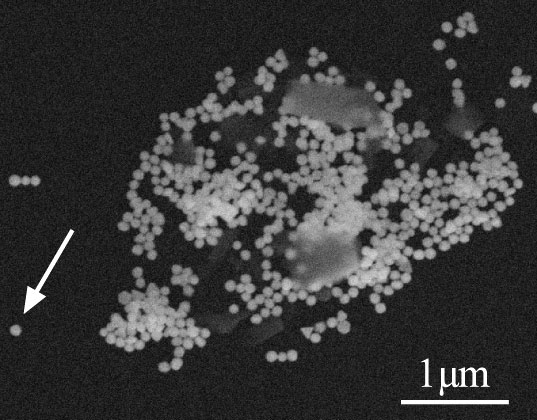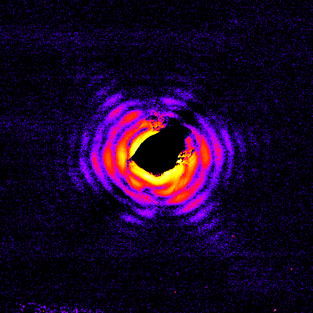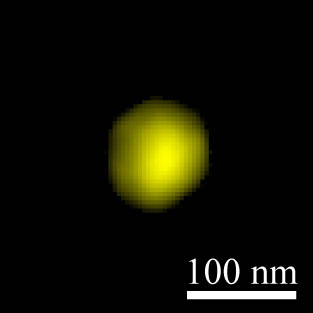- Home
- News
- Spotlight on Science
- Gold nanoparticle...
Gold nanoparticle imaged with 5 nm spatial resolution
03-10-2008
A gold nanoparticle was imaged with the record spatial resolution of 5 nanometres by using coherent X-ray diffraction imaging or so-called lensless imaging with a focused beam. Conventional X-ray microscopy is limited by the performance of X-ray optics. Lensless imaging does not have this limitation. Its resolution, however, is limited by the coherent flux on the sample. By efficiently focusing the coherent photons onto the sample, the highest spatial resolutions can be achieved.
Share
The short wavelength of X-rays allows one to probe matter on atomic length scales. In crystallography, for example, the structure of molecules arranged in a crystal can be determined with atomic resolution. In principle, X-rays should also allow one to build a microscope to directly image a sample with high spatial resolution. However, besides the short wavelength of the radiation, such a microscope requires an objective lens that captures the radiation within a large solid angle from the sample. The weak interaction of hard X-rays with matter and technological challenges make it very difficult to fabricate X-ray lenses with such large numerical apertures.
One way to work around this is to abandon the use of an objective lens in the microscope and record the light scattered by the sample directly on a detector that covers a large solid angle, much like in crystallography. The price to pay is that the image recorded on the detector is not the direct image of the sample but its far-field diffraction pattern. The object itself can be recovered numerically from such a diffraction pattern [1], provided one has some knowledge of the sample, such as its overall size.
In order to obtain a nice and clean diffraction pattern, the sample has to be illuminated with coherent X-rays. This calls for the high brilliance of a modern synchrotron radiation source, such as the ESRF, that can provide a large coherent flux in the hard X-ray range. When a small object is placed into such a beam, a clean diffraction pattern can be recorded. Typically, the intensity in the diffraction pattern decays strongly with increasing scattering angle. Thus, for a given exposure time, the diffraction pattern is statistically significant only inside a certain solid angle, effectively limiting the spatial resolution of the technique. At modern synchrotron radiation sources, such as the ESRF, illuminating an object for about an hour with a plane coherent beam yields a spatial resolution of a few 10 nm. Increasing the spatial resolution by one order of magnitude, for instance, would require the exposure time to be lengthened by about four orders of magnitude, e.g., going from one hour of exposure for a few tens of nm to over a year of exposure for a resolution of a few nanometres.
To overcome this severe practical limit, the coherent flux density on the sample needs to be maximised. This is most effectively achieved by focusing the coherent X-rays onto the sample. Using the X-ray scanning microscope developed at TU Dresden in collaboration with beamline ID13, we have focused hard X-rays (energy E = 15.25 keV, wavelength λ = 0.813 Å) to a 100 x 100 nm2 spot, preserving the coherence and a flat wave front in the focus. In this way, the coherent flux density was increased by four orders of magnitude, effectively improving the spatial resolution of the technique by one order of magnitude.
 |
|
Figure 1. Scanning electron micrograph of a cluster of gold nanoparticles on a Si3N4 membrane. The arrow points to the particle under investigation. |
The scheme was verified by recording a diffraction pattern of a single gold nanoparticle placed on a thin Si3N4 membrane (Figure 1). During 10 minutes of exposure, the diffraction pattern in Figure 2 was recorded on a FReLoN 4M diffraction camera. From this diffraction pattern, the gold particle shown in Figure 3 was reconstructed by iterative phase retrieval techniques with a spatial resolution slightly below 5 nm. This record breaking spatial resolution could only be achieved with the focused beam. With unfocused illumination, the exposure would have taken more than two months to achieve the same result.
This experiment opens the way to X-ray microscopy with spatial resolution in the nanometre range. By focusing the X-rays more efficiently, the spatial resolution can be improved further in the future, and in combination with scanning microscopy, larger samples can be investigated as well [2]. In this way, the technique can provide insight into the structure of non-crystalline nanoscale objects, such as catalyst particles, nanoelectronic devices or biomolecules, which is crucial to push chemistry, nanotechnology, or structural biology to new frontiers. As X-rays can penetrate the sample and various sample environments, it can be used to investigate buried structures and samples in situ, e.g., inside a chemical reactor, a strong magnetic field, or under high pressure. The development of this technique is part of the ESRF upgrade programme and will greatly enhance the microscopy capabilities at the ESRF.
 |
|
Figure 2. Diffraction pattern of the gold nanoparticle indicated by the arrow in Figure 1. The pattern was recorded in the forward direction in 600 s by a FReLoN 4M detector. |
 |
|
Figure 3. Reconstruction of the gold nanoparticle from the diffraction pattern in Figure 2 with a spatial resolution of about 5 nm. |
References
[1] J.R. Fienup, Phase retrieval algorithms: a comparison, Appl. Opt. 21, 2758 (1982).
[2] P. Thibault, M. Dierolf, A. Menzel, O. Bunk, C. David, F. Pfeiffer, High-resolution scanning X-ray difraction microscopy, Science 321, 379–382 (2008).
Principal publication and authors
C.G. Schroer (a), P. Boye (a), J.M. Feldkamp (a), J. Patommel (a), A. Schropp (a,c), A. Schwab (a), S. Stephan (a), M. Burghammer (b), S. Schöder (b), C. Riekel (b), Coherent X-ray diffraction imaging with nanofocused illumination, Physical Review Letters 101, 090801 (2008).
(a) Institute of Structural Physics, Technische Universität Dresden (Germany)
(b) ESRF
(c) HASYLAB at DESY, Hamburg (Germany)



